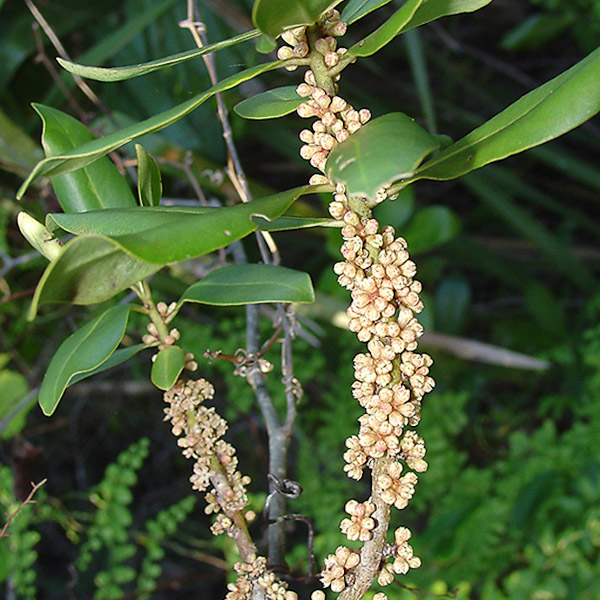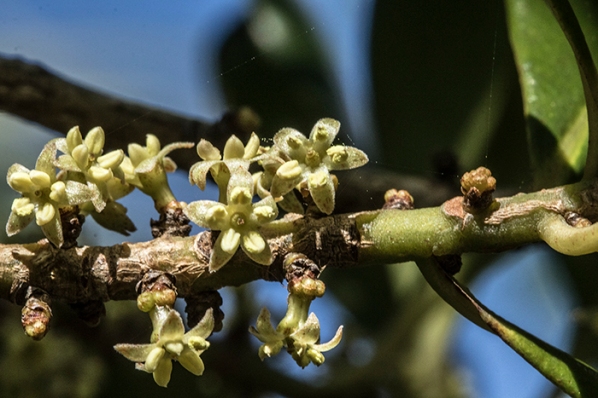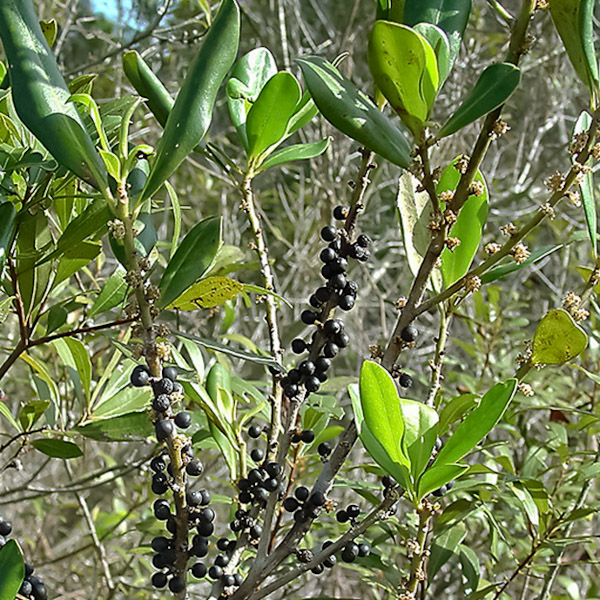Myrsine cubana and the junky trunk
(Myrsine is an ancient Greek name for a shrub, and may trace back to myrrh. Cubana refers to Cuba.)
Myrsinaceae
(Readers will find this plant under divergent species and family names. It has a messy history. Here we follow the Flora of North America.)
John and I wandered dodging cacti over sunny hill and sandy dune in the scenic Jupiter Lighthouse Inlet Lighthouse Outstanding Natural Area today, formerly a Coast Guard LORAN navigation station by Tequesta, Florida.
Our local Sahara Desert scrub is always a living museum, at least when not 94 degrees, and likewise interesting is the interface where scrub meets mangrove seashore. Such borders are often home to a mixed bag of species. Today there in bloom was Myrsine, a shrub popular among native landscapers decoratively and as birdfood. Our species is just one of approximately 300 species of Myrsine. In Florida Myrsine cubana favors near-mangrove areas and coastal hammocks.
The flowers are mostly unisexual, and many folks describe the species as dioecious (dye-EE-shus), that is, with separate male and female individuals, although the truth is more complex. The authoritative Flora of North America avoids tagging it as that.

Myrsine stems with flowers, by John Bradford.
The little cream-colored flowers sit crowded along older woody branches, partly hidden among the leaves. Somewhere along the line my students started describing it as having its “junk on the trunk” (hey, don’t look at me), although I don’t think the trunk itself has flowers.

Myrsine flowers today.
The term for bearing flowers and fruits along older branches or on the trunk is cauliflory. Familiar examples include chocolate, jaboticaba, and mastic, or for northerners, redbud. Cauliflory turns up sporadically among the flowering plants, having evolved independently in many different families. Why?
There is probably no single reason, although botanists seem to find the condition mostly tropical, and probably with at least three benefits in addition to strurdiness: 1) In a tropical forest having a multitiered canopy many insect pollinators live “down low,” not out at the tips of the ultimate branches. 2. In a tropical forest, not all potential pollinators fly. Stem-borne flowers invite pollen dispersal from crawling insects, lizards, small mammals, mangrove crabs, and treefrogs. 3. Birds don’t always fly; they also sidestep along branches. That could help distribute pollen, and more importantly, perching birds as well as rodents can feast on the thousands of small black berrylike Myrsine fruits and help disperse the seeds.

Junk on the trunk, by JB.
plasticsfl@earthlink.net
November 17, 2017 at 9:37 pm
Thank you for sending these to me. Very much appreciated.
Annie Hite
November 18, 2017 at 7:20 am
I was considering a spot for a short walk today so now the Jupiter Lighthouse area and myrsine are calling! The last time I walked there, I noticed lots of nicker bean in bloom (first time, hooray) and also some balsam apple (not so good) creeping in. And, by the way, love your books.
Uncle Tree
November 18, 2017 at 5:50 pm
You make the most mundane thangs comical, George. 🙂 Great pics, and cool glory-story!
Linda Grashoff
November 19, 2017 at 2:34 pm
I’m happy to have a word for what I see on the redbud trees here up north—and a guess for why they do it. Thanks!
Chris Lockhart
November 19, 2017 at 4:14 pm
Great topic and great photos. Thanks.
Also good to have a few plants to consider as the tides move more into our landscapes.
Happy Thanksgiving!